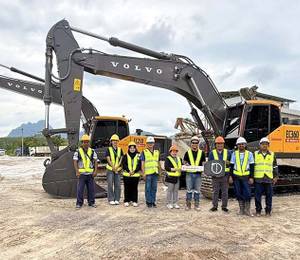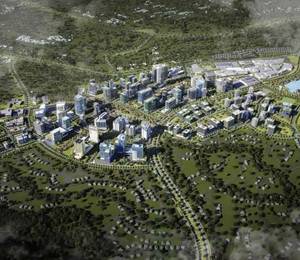The Indonesian capital Jakarta is a highly populated city with immense congestion. To address this issue – and also reduce carbon emissions from the road traffic – the provincial government Daerah Khusus Ibukota (DKI) Jakarta decided on a more sustainable mobility solution. As a result, DKI began construction of the city’s first mass rapid rail system in 2013 by way of its land transportation authority PT Moda Raya Terpadu, known as PT MRT Jakarta (Perseroda).
“Previously in Indonesia, not only in Jakarta, the government was focused on private vehicle infrastructure development, such as toll roads, urban roads and parking areas. Today, the trend is slowly changing with the government now giving more attention to support an integrated public transportation system that is able to raise public interest in the shift from private vehicles to public transportation,” explained Silvia Halim, director of construction at PT MRT Jakarta (Perseroda). The company will operate the entire commuter rail line, MRT Jakarta, once the project is complete.
Expansive rail network
Despite often stand-still traffic, there has been minimal interest in using public transit, with most Jakartans believing that driving is the most effective form of travel. Many have expressed concern about the comfort, safety and longer commute times associated with unintegrated mass transit, according to Ms Halim. However, the development of MRT Jakarta as a safe, unified and sustainable rapid railway is expected to change public perception and in turn increase public transit use.
MRT Jakarta is an expansive rail network that will ultimately connect all corners of the greater metropolitan area to its centre. The layout will disperse future city growth and create new urban centre, which will provide more opportunity for development in Jakarta’s suburbs and stimulate the economic value of the areas around each station.
As part of this planned urban expansion, increased accessibility to transit stations in the suburbs will alter traffic patterns, contributing to a reduction in roadway congestion. PT MRT Jakarta (Perseroda) aims to raise public transportation use from around 30% currently to as high as 60% in the future.
“Stations have been built at strategic points across the capital city of Jakarta and are connected to other modes of public transportation to make it easy for passengers to reach their destinations,” said Ms Halim.
A decades-long project
The approximately 23-km north-south corridor was planned to be delivered in two phases. Phase 1 consisted of building a 16-km line from Lebak Bulus Grab Station to Bundaran HI Station. This section was built first because the majority of Jakarta’s working population lives in the area.
Phase I was opened to commuters in March 2019, comprising 13 stations. Given the public’s reliance on vehicular travel, PT MRT Jakarta (Perseroda) expected usage to grow slowly. Citizens were reportedly “sceptical” about the railway, citing concern over fare costs and its integration with other mass transit systems.
Ms Halim mentioned that the Jakarta government has “provided subsidies for the operation of the MRT Jakarta so that the costs are in accordance with the public’s ability.”
Since operation of the transit system began, traffic congestion has reduced, vehicle speed has increased by 3%, and particulate matter pollution has decreased by 18%, according to a 2021 study from Institute for Economic and Social Research, University of Indonesia. In 2019, the rail line saw almost 95,000 more passengers per day, 30,000 more than anticipated. One of the reasons for its swift success has been the reliability of the automated train system.
“In an effort to support citizen mobility, MRT Jakarta’s service operations have managed to achieve a 99.88% on-time performance that includes the time to travel from one station to another, a 99.92% exact train dwelling time at stations, and 99.82% arrival punctuality at stations,” revealed Ms Halim.
As commuters have been able to successfully ride on this rail line and recognise its consistency for several years, the public now has greater confidence in the next stage of the project, according to MRT Jakarta’s president director William Sabandar, speaking in a 2019 interview with McKinsey & Company.
Phase 2 of the project continues the north-south corridor railway line from the Bundaran HI roundabout to West Ancol for a total of 11.8 km. Currently under construction, Phase 2 is being divided into two stages, with the first stage stretching to Harmoni Station scheduled to be operational in April 2025, and the second stage projected to be completed in 2027.
PT MRT Jakarta (Perseroda) used Bentley Systems’ digital twin and project management software to centralise project information and streamline design collaboration. Due to the global pandemic that postponed Phase 2, MRT Jakarta was asked to speed up this next stage of the project, which meant ensuring there were no delays caused by data inaccuracies, blockages in design reviews, or miscommunications. Using a connected data environment enabled real-time access to rail design and saved approximately 10% of time.
In parallel with the completion of the north-south corridor, MRT Jakarta is developing and preparing an east-west corridor stretching from Kalideres to Ujung Menteng, considered Phase 3. While Phase 4 will involve construction of railway lines that form an outer loop in the southern section of Jakarta.
Easy access to railway stations
PT MRT Jakarta (Perseroda) is focused on urban regeneration and developing infrastructure that “excels in all ways.” Consequently, the railway stations follow the guidelines of a transit-oriented development (TOD) masterplan, which improves access to the station and offers a better pedestrian experience through open green spaces and enhanced sidewalks, bridges and streetscapes for those walking and bicycling to the station.
“Not only are MRT stations close to office areas, but they are also located near a variety of shopping and culinary centres, as well as popular tourist attractions,” said Ms Halim. The guidelines of development around the MRT stations incorporated improved connectivity to these locales and preservation of any existing heritage sites near the stations.
Additionally, the stations are energy efficient, utilising electricity as their main power source, and they are equipped with LED lighting, non-CFC air conditioning, and energy-efficient platform screen doors at train entrances that block heat from the rail.
“The creation of MRT Jakarta represents a breakthrough in public transportation,” concluded Ms Halim. “Not only does it increase mobility, but MRT Jakarta also brings with it a number of other benefits, such as improving the quality of the city’s air and becoming a solution to the capital’s serious traffic congestion problem while transforming people’s life habits as they gradually switch from the use of private vehicles to public transportation.”
All images: PT MRT Jakarta (Perseroda)
Note: The MRT Jakarta Phase 2 project has been named a finalist of Going Digital Awards in Infrastructure 2021 (under the Rail and Transit category) by Bentley Systems.














